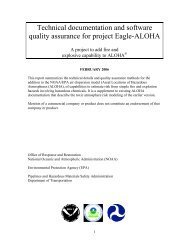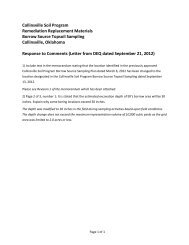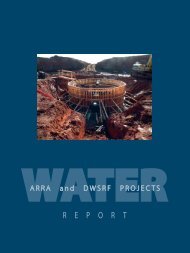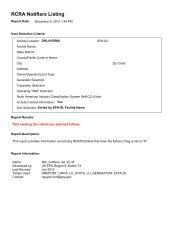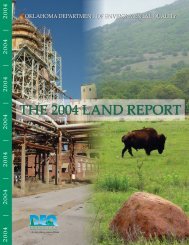Oklahoma Gas & Electric Muskogee Generating Station Best ...
Oklahoma Gas & Electric Muskogee Generating Station Best ...
Oklahoma Gas & Electric Muskogee Generating Station Best ...
You also want an ePaper? Increase the reach of your titles
YUMPU automatically turns print PDFs into web optimized ePapers that Google loves.
<strong>Oklahoma</strong> <strong>Gas</strong> & <strong>Electric</strong><br />
<strong>Muskogee</strong> <strong>Generating</strong> <strong>Station</strong> – BART Determination<br />
May 28, 2008<br />
reduce overall NOx emissions from <strong>Muskogee</strong> Units 4 & 5 by approximately 3,456 tpy<br />
(compared to advanced combustion controls); however, the incremental cost associated with<br />
this reduction is approximately $57,407,600 per year, or $16,611/ton.<br />
As part of the BART rulemaking, EPA established presumptive NOx emission limits applicable<br />
to EGUs greater than 200 MW at power plants with a generating capacity greater than 750<br />
MW. The presumptive NOx emission limits were based on control strategies that EPA<br />
considered to be generally cost-effective for such units (see, 70 FR 39134). The presumptive<br />
NOx emission limit applicable to <strong>Muskogee</strong> Units 4 & 5 (tangentially-fired units firing<br />
subbituminous coal) is 0.15 lb/mmBtu. For all types of boilers, other than cyclone units, the<br />
presumptive limits were based on the use of combustion control technologies. EPA estimated<br />
that the “costs of such controls in most cases range from just over $100 to $1000 per ton” (see,<br />
70 FR 39135).<br />
The average cost effectiveness of combustion controls (LNB/OFA) on <strong>Muskogee</strong> Units 4 & 5 is<br />
similar to the BART cost-effectiveness developed by EPA for NOx control on large EGU<br />
boilers. Both the average and incremental cost effectiveness of SCR on <strong>Muskogee</strong> Units 4 & 5<br />
are significantly greater than the cost effectiveness of NOx control at other BART-applicable<br />
units. The costs associated with SCR would result in significant economic impacts on the<br />
<strong>Muskogee</strong> <strong>Generating</strong> <strong>Station</strong> (approximately $57,407,600 per year additional costs).<br />
Therefore, SCR should not be selected as BART based on lack of cost effectiveness. Although<br />
SCR does not appear to be cost effective, it will be included in the evaluation of the remaining<br />
factors to assure that the BART determination considers all relevant information.<br />
3.4.2 NOx Control Technologies – Environmental Impacts<br />
Combustion modifications designed to decrease NOx formation (lower temperature and less<br />
oxygen availability) also tend to increase the formation and emission of CO and VOCs.<br />
Therefore, the combustion controls must be designed to reduce the formation of NOx while<br />
maintaining CO and VOC formation at an acceptable level. Other than the NOx/CO-VOC<br />
trade-off, there are no environmental issues associated with using combustion controls to<br />
reduce NOx emissions.<br />
Operation of an SCR system has certain collateral environmental consequences. 13 First, in<br />
order to maintain low NOx emissions some excess ammonia will pass through the SCR.<br />
Ammonia slip will increase with lower NOx emission limits, and will also tend to increase as<br />
the catalyst becomes deactivated. Ammonia slip from an SCR designed to achieve a controlled<br />
13 See, Hinton, W.S., Cushing, K.M., Gooch, J.P., “Balance-of-Plant Impacts Associated with SCR/SNCR<br />
Installations”, proceedings of the ICAC Forum, 2002.<br />
25



